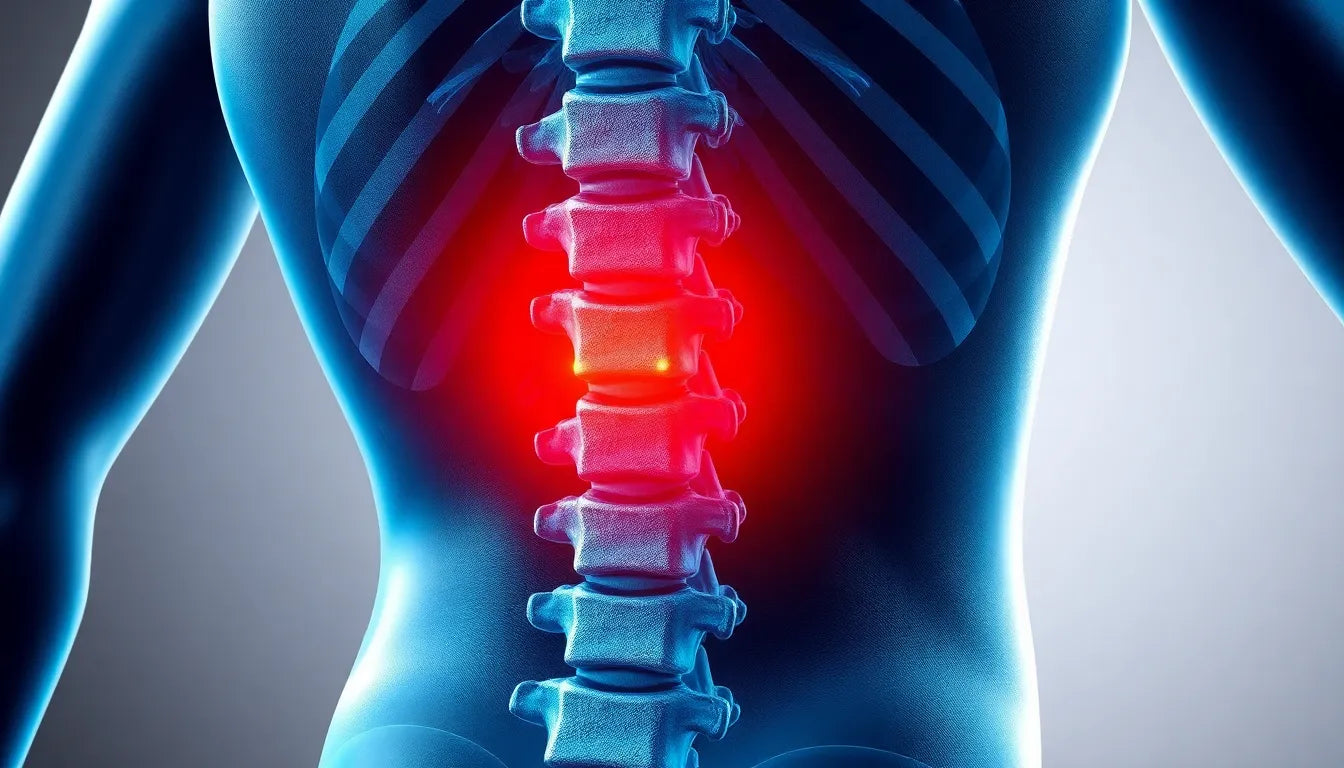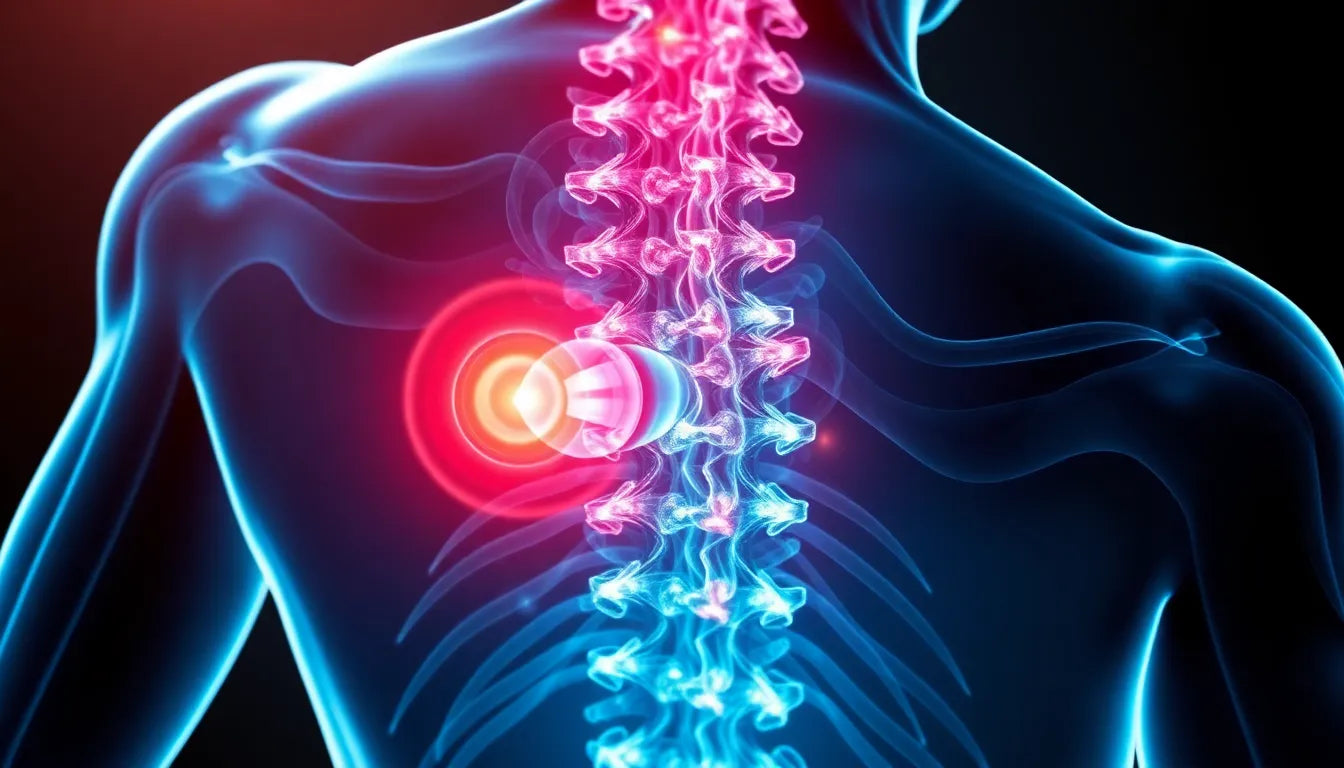Back pain is a common ailment that affects millions worldwide, disrupting daily routines and diminishing quality of life. Among the many causes of back pain, herniated discs stand out as a frequent culprit. Yet, despite their prevalence, the causes of herniated discs are often shrouded in mystery and misunderstanding. This begs the question: what really leads to a herniated disc?
Understanding herniated discs
A herniated disc occurs when the soft, gel-like center of a spinal disc pushes through a crack in its tougher exterior. This condition can cause significant discomfort and pain, often radiating through the back and into the limbs, depending on the location of the herniation. To grasp the full picture, it's essential to understand the basic anatomy of spinal discs and their critical role in our body's structure.
Spinal discs are the cushion-like pads situated between each vertebra in the spine. These discs serve a crucial function, acting as shock absorbers that allow for flexibility and movement while protecting the spinal column. Each disc is composed of a tough outer layer, known as the annulus fibrosus, and a softer inner core, called the nucleus pulposus. When the outer layer weakens or tears, it can allow the inner core to protrude, leading to what we know as a herniated disc.
The occurrence of a herniated disc can be influenced by various factors, and understanding these elements is key to preventing and managing this painful condition. In the following sections, we will delve deeper into the primary causes and risk factors that contribute to disc herniation, providing a comprehensive look at how lifestyle choices, genetic predispositions, and occupational strains play a role in spinal health.
Primary causes of herniated discs
The development of a herniated disc is often attributed to several primary causes, each contributing to the weakening or damage of the spinal discs. Understanding these causes can help individuals take proactive measures to protect their spinal health and reduce the risk of herniation.
Aging and degeneration
One of the most significant contributors to herniated discs is the natural aging process, which leads to disc degeneration. As we age, the spinal discs lose water content, making them less flexible and more prone to tearing or rupturing. This degeneration reduces the disc's ability to absorb shock, increasing the likelihood of the nucleus pulposus pushing through the annulus fibrosus, resulting in herniation. This process is a common occurrence and is considered a natural part of aging, often affecting individuals over the age of 50.
Injury or sudden strain
While aging is a gradual process, herniated discs can also result from sudden injuries or strains. Engaging in activities that involve improper heavy lifting, sudden twisting motions, or unexpected impacts can place excessive stress on the spinal discs. This is particularly true for younger individuals whose discs may not yet show signs of degeneration. A single traumatic event can cause the outer layer of the disc to tear, allowing the inner gel-like core to protrude and cause a herniation.
Repetitive movements and poor posture
Daily activities that involve repetitive lifting, bending, or twisting can also contribute to the development of herniated discs. These repetitive motions increase pressure on the discs over time, leading to wear and tear. Additionally, poor posture, whether sitting or standing, can place undue stress on the spine, exacerbating the risk of herniation. Maintaining proper posture and using ergonomic techniques can help mitigate these risks and promote better spinal health.
Risk factors contributing to herniation
Beyond the primary causes, several risk factors can increase an individual's susceptibility to herniated discs. Identifying and addressing these factors can play a crucial role in preventing disc herniation and maintaining overall spine health.
Environmental and lifestyle factors
Lifestyle choices significantly impact spinal health. Obesity, for instance, places additional strain on the spine, accelerating disc degeneration. Smoking is another factor that can negatively affect disc health by reducing blood flow and oxygen to the spinal tissues, impairing their ability to heal and maintain strength. A sedentary lifestyle, characterized by prolonged periods of inactivity, can also weaken the muscles supporting the spine, increasing the risk of herniation.
Genetic predisposition
Genetics can play a role in the likelihood of developing herniated discs. Some individuals inherit a predisposition to disc degeneration or structural abnormalities in the spine, making them more susceptible to herniation. While genetic factors cannot be changed, understanding one's family history can help in taking preventive measures to protect spinal health.
Occupational strains
Certain occupations are associated with a higher risk of developing herniated discs due to the physical demands they place on the spine. Jobs that require frequent lifting, bending, or twisting, such as construction work or manual labor, can increase the likelihood of disc herniation. Additionally, occupations that involve prolonged sitting, such as driving or office work, can contribute to spinal stress if ergonomic practices are not implemented. Incorporating regular breaks, proper lifting techniques, and ergonomic adjustments can help mitigate these occupational risks.
By recognizing the primary causes and risk factors associated with herniated discs, individuals can take informed steps to protect their spine health. Whether through lifestyle adjustments, ergonomic improvements, or preventive strategies, understanding these elements is key to reducing the likelihood of experiencing this painful condition.
Preventive measures for herniated discs
Understanding the causes and risk factors of herniated discs is a crucial step toward prevention. By making informed lifestyle adjustments and adopting preventive strategies, individuals can significantly reduce their risk of developing this painful condition. Here are some effective measures to consider:
Maintain a healthy weight: Carrying excess weight puts additional pressure on the spine, accelerating disc degeneration. A balanced diet and regular exercise can help maintain a healthy weight, reducing stress on spinal discs.
Quit smoking: Smoking impairs blood flow and oxygen to spinal tissues, hindering their ability to heal and maintain strength. Quitting smoking can improve overall spinal health and reduce the risk of herniation.
Engage in regular exercise: Regular physical activity strengthens the muscles supporting the spine, enhancing stability and reducing the risk of injury. Core-strengthening exercises, in particular, are beneficial for maintaining spinal health.
Practice proper lifting techniques: When lifting heavy objects, use your legs rather than your back to avoid placing excessive strain on your spinal discs. Bend at the knees and keep the object close to your body to minimize stress on the spine.
Incorporate ergonomic aids: Ergonomic tools and adjustments in the workplace or home can significantly reduce repetitive stress on the spine. Consider using ergonomic chairs, standing desks, and supportive footwear to promote better posture and reduce strain.
Frequently Asked Questions
Can a herniated disc heal on its own?
In many cases, the symptoms of a herniated disc improve over time with rest and conservative treatments such as physical therapy, pain management, and lifestyle adjustments. However, some cases may require medical intervention, such as surgery, if symptoms persist or worsen.
Are herniated discs more common in certain age groups?
Herniated discs are most common in males aged 20-50, but they can occur in individuals of any age due to various risk factors. Aging naturally increases the risk due to disc degeneration, but younger individuals can also experience herniation from injury or strain.
How can I prevent a herniated disc?
Preventing a herniated disc involves maintaining a healthy lifestyle, using proper techniques for lifting, and incorporating ergonomic support in daily activities. Regular exercise, particularly core strengthening, and avoiding smoking are also important preventive measures.
Is surgery always required for a herniated disc?
Surgery is typically considered only after conservative treatments have failed to alleviate symptoms. Most individuals experience relief with non-surgical methods, but in severe cases, surgery may be necessary to relieve pressure on the spinal nerves.
By understanding the causes and risk factors of herniated discs, individuals can take proactive steps to protect their spine health and reduce the likelihood of developing this painful condition. Incorporating preventive measures and making lifestyle adjustments can significantly improve spinal health and overall well-being.
Sources
- American Academy of Orthopaedic Surgeons (AAOS). "Herniated Disk in the Lower Back." OrthoInfo.
- National Center for Biotechnology Information (NCBI). "Genetic Factors and Lumbar Disc Disease." Public Health Genomics.
- Johns Hopkins Medicine. "Herniated Disc."
- Stanford Health Care. "Lumbar Disc Disease."
- Riverhills Neuroscience. "Herniated Disc."


















